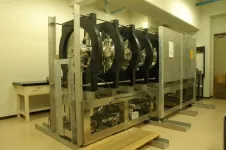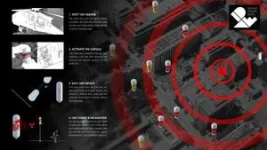Positron, the antiparticle of electron, has the same mass and charge as that of an electron but with the sign flipped for the charge. It is an attractive particle for scientists because the use of positrons has led to important insights and developments in the fields of elementary particle physics, atomic physics, materials science, astrophysics, and medicine. For instance, positrons are known to be components of antimatter. They are also powerful in detecting lattice defects in solids and semiconductors and in structural analysis of the topmost surface of crystals. Positronic compounds, namely bound states of positrons with regular atoms, molecules, or ions, represent an intriguing aspect of positron–matter interactions and have been studied experimentally via observation of positron annihilation in gases. It may be possible to generate new molecules and ions via the formation of positron compounds, but no research has ever been done from such a perspective.
Against this backdrop, a research team including Professor Yasuyuki Nagashima from Tokyo University of Science (TUS), Japan, has recently found an innovative way to explore the interactions between positrons and ionic crystals. Their work, published in Physical Review Letters, involved collaborative efforts from Dr. Takayuki Tachibana, former Assistant Professor at TUS and currently affiliated with Rikkyo University, and Mr. Daiki Hoshi, a former graduate student at TUS.
The researchers used a technique based on a well-explored phenomenon arising from the bombardment of a solid with an electron beam. “It has long been known that when electrons are injected into a solid surface, atoms that make up the surface are ejected as monoatomic positive ions,” explains Dr. Tachibana. This process, known as electron-stimulated desorption, motivated the team to explore what would happen if a crystal was instead bombarded with positrons.
In their experiments, the researchers shot either a positron or electron beam at the (110) surface of a lithium fluoride (LiF) crystal. Using carefully placed electric fields generated by deflectors, they controlled the incident energies of the charged particles. Moreover, the deflectors enabled them to redirect any ions desorbed from the crystal towards an ion detector. The detected signals were then used to conduct spectroscopic analysis to identify the precise composition of the desorbed ions.
They found that when the LiF crystal was irradiated with electrons, only the expected monoatomic ions, namely Li+, F+, and H+ (due to residual gases in the experimental chamber) were detected. However, injecting the crystal with positrons led to the detection of positive molecular fluorine ions (F2+) and positive hydrogen fluoride ions (FH+). Notably, this is the first-ever report of molecular ions being ejected upon positron irradiation.
After further analysis and experimentation, the researchers developed a desorption model to explain their observations. According to this model, as positrons are injected into a solid, some of them return to the surface after losing their energy. In the case of LiF crystals, these positrons may attract two neighboring fluorine negative ions on the surface to form a positronic compound. If the bound positron annihilates with one of the fluorine ion’s core electrons, a special type of electron, known as an Auger electron, is emitted, resulting in a charge swap and the generation of a positive F2+ molecular ion. This ion is pushed out of the crystal by the repulsing forces of the nearby Li+ ions.
The findings of this study could further our understanding of matter–antimatter interactions. “The stability and binding properties of positronic compounds provide unique perspectives on the interaction of antiparticles with ordinary substances, paving the way for novel investigations in the field of quantum chemistry,” remarks Dr. Tachibana. “The proposed method could thus pave the way for the generation of new molecular ions and molecules in the future.”
Notably, the approach could be leveraged in many applied fields. In materials science, it could be used to modify the surface of materials and study their properties with unprecedented precision. Other potential applications include cancer therapy, quantum computing, energy storage, and next-generation electronic devices.
Let us hope that future studies will further unravel the potential of positrons!
***
Reference
DOI: https://doi.org/10.1103/PhysRevLett.131.143201
About The Tokyo University of Science
Tokyo University of Science (TUS) is a well-known and respected university, and the largest science-specialized private research university in Japan, with four campuses in central Tokyo and its suburbs and in Hokkaido. Established in 1881, the university has continually contributed to Japan's development in science through inculcating the love for science in researchers, technicians, and educators.
With a mission of “Creating science and technology for the harmonious development of nature, human beings, and society,” TUS has undertaken a wide range of research from basic to applied science. TUS has embraced a multidisciplinary approach to research and undertaken intensive study in some of today's most vital fields. TUS is a meritocracy where the best in science is recognized and nurtured. It is the only private university in Japan that has produced a Nobel Prize winner and the only private university in Asia to produce Nobel Prize winners within the natural sciences field.
Website: https://www.tus.ac.jp/en/mediarelations/
About Professor Yasuyuki Nagashima from Tokyo University of Science
Yasuyuki Nagashima obtained his master's and doctoral degrees from the Department of Physics of the University of Tokyo. He joined Tokyo University of Science as Associate Professor in 2003 and was promoted to Full Professor in 2007. His laboratory focuses mainly on positron physics, including the study of positronium negative ions and positronium beam experiments. He has published around 130 papers on these topics, which have been cited over 2,000 times. He received the Hiroshi Takuma Memorial Prize of Matsuo Foundation in 2020.
Funding information
This work was supported by Grants-in-Aid for Scientific Research (KAKENHI; Grant Number JP20K12498 ).
END





